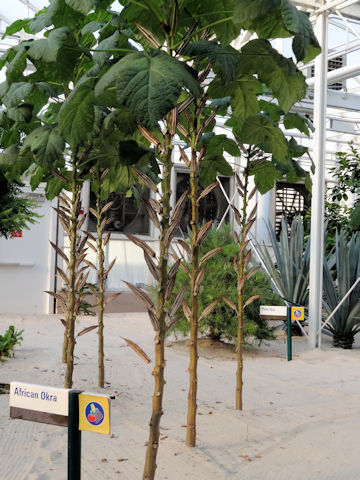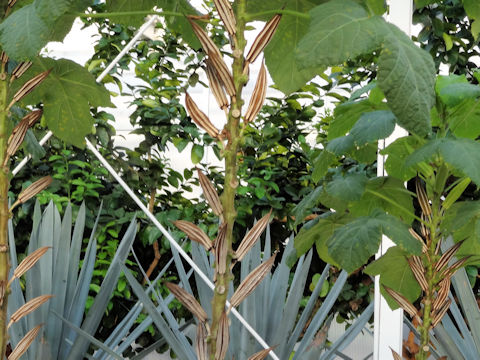 |




|

|
西アフリカおよび中央アフリカが原産です。「オクラ」と「とろろあおい(黄蜀葵)」との交配種だと報告されています。何世紀にもわたって西アフリカの沿岸国で栽培されてきましたが、最も一般的には標高1000メートルまでの低い標高で栽培されています。植物は4メートルの高さに達し、3年まで生き残ることができます。長さ8〜12センチの中型の莢で、短日条件でも莢を生産し続けます。ウェストアフリカンオクラは、継続的に収穫すると多くの莢を生産します。いくつかの方法で野菜として使われますが、若い葉は「ほうれんそう」として、若い果実は調理または揚げられた後に使われます。種子は灰色から緑色で、一般的なオクラよりも丸い形をしています。その葉はまた、優れた家畜の飼料になります。これと同じ交配種は、日本で実験的に生産され、「のりあさ(糊麻)」として知られています。
|

|
アオイ科トロロアオイ属の半多年草で、学名は Abelmoschus caillei。英名は West African okra、African okra。
|

|
The West African okra (Abelmoschus caillei) belongs to Malvaceae (the Mallow family). It is a semi-perennial herb that is native to West and Central Africa. It is reported to be a hybrid of "Okra" (Abelmoschus esculentus) and "Aibika" (Abelmoschus manihot). This herb bas been grown in coastal nations of West Africa for centuries, it is most commonly grown in low elevations up to 1000 m. The plants can reach a height of 4 m and survive up to 3 years. It has mid-sized, 8-12 cm long pods and continues to produce pods even when days are short. The Western African okra produces many pods if harvested continuously. It is consumed as a vegetable in a few ways, with young leaves consumed as spinach, young fruits consumed after being cooked or fried. Seeds are grey to green and more round in shape than common okra. Its leaves also make good cattle feed. The same hybrid was produced experimentally in Japan where it is known as "Nori-asa" (Abelmoschus x glutinotextilis).
|

|
アメリカ・フロリダ州オーランド市「エプコット」にて、2012年09月23日撮影。(photo by Jon Suehiro)
|

